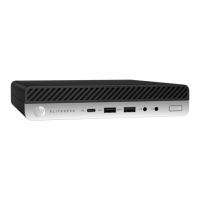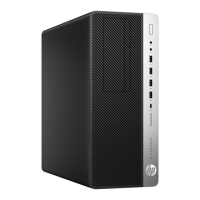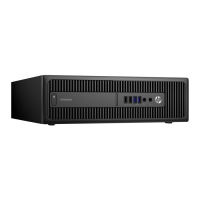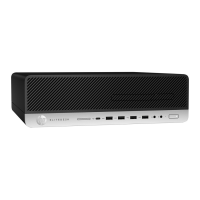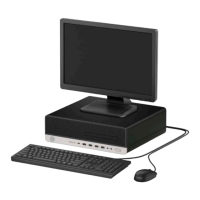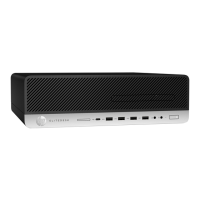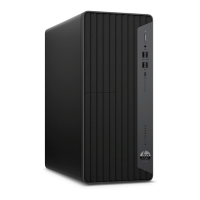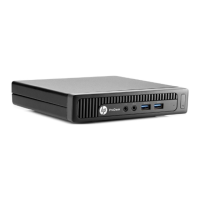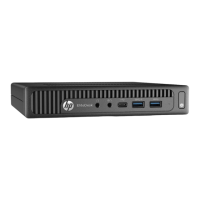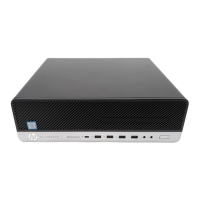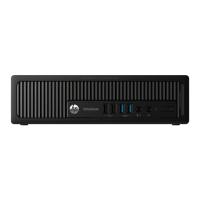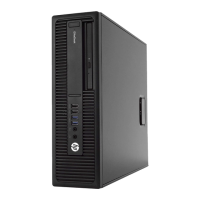Do you have a question about the HP EliteDesk 800 G3 SFF and is the answer not in the manual?
Describes the standard features of the computer, which may vary by model.
Details the components located on the front of the HP EliteDesk 800 G3 SFF Business PC.
Details the components located on the rear of the HP EliteDesk 800 G3 SFF Business PC.
Explains where to find the unique serial number and product ID on the computer.
Lists and illustrates major components and spare parts for the SFF chassis.
Illustrates and lists various smaller or miscellaneous parts for the SFF chassis.
Lists and illustrates various cables and adapters used with the computer.
Lists various system boards, expansion cards, and ports available for the computer.
Lists the various types of hard drives and optical drives supported by the computer.
Explains the risks of electrostatic discharge (ESD) and how it can damage components.
Provides precautions and methods to prevent damage from electrostatic discharge.
Details equipment like wrist straps for preventing static electricity damage.
Outlines precautions for grounding the work area to prevent static damage.
Lists recommended materials and tools for preventing static electricity.
Provides guidelines to prevent overheating and prolong the life of the computer.
Covers general cleaning safety precautions for the computer and its components.
Lists considerations for disassembly and assembly of the computer.
Lists the necessary tools and software for servicing the computer.
Outlines initial safety procedures and steps before disassembling the computer.
Describes how to remove and install the computer's access panel for internal access.
Details the procedure for removing and installing the front bezel of the computer.
Explains how to remove the bezel blank covering the slim optical drive bay.
Covers the procedure for removing, cleaning, and replacing the front bezel dust filter.
Identifies system board connectors and their corresponding components.
Provides specifications for DDR4-SDRAM memory modules and how to install them.
Explains how DIMM sockets are populated for single, dual, or flex memory modes.
Step-by-step guide for removing and installing memory modules (DIMMs).
Details how to remove, replace, or add PCI Express expansion cards.
Lists drive positions and general guidelines for installing and removing drives.
Provides instructions for removing the 9.5 mm slim optical drive from the computer.
Provides instructions for installing the 9.5 mm slim optical drive into the computer.
Step-by-step guide for removing a 3.5-inch hard drive from the computer.
Step-by-step guide for installing a 3.5-inch hard drive into the computer.
Describes how to rotate the hard drive cage for component access.
Provides instructions for removing a 2.5-inch hard drive from the computer.
Provides instructions for installing a 2.5-inch hard drive into the computer.
Details how to remove and install M.2 SSD storage cards in the computer.
Explains how to remove and install the WLAN module.
Describes how to remove and reinstall the air duct for component access.
Provides procedures for removing and installing the computer's power supply unit.
Details how to remove and install the fan sink assembly for the processor.
Step-by-step instructions for removing and installing the computer's processor.
Explains how to remove and replace the WLAN antennas.
Describes how to remove and install an optional port expansion board.
Details the procedure for removing and installing the computer's hood lock.
Explains how to remove and install the hood sensor for chassis intrusion detection.
Provides instructions for removing and installing the computer's card reader.
Details how to remove and install the internal speaker.
Covers the removal and replacement of the main system board.
Identifies various connectors and components on the system board.
Explains how to reorient the computer from a desktop to a tower configuration.
Lists the various functions and capabilities of the Computer Setup (F10) Utility.
Provides step-by-step instructions on how to access and navigate the Computer Setup utility.
Details the options available within the Main section of the Computer Setup utility.
Covers security settings, including BIOS administrator and user passwords.
Describes advanced configuration options for users.
Explains how to access the UEFI driver management application.
Details how to save and restore computer configuration settings using USB media.
Provides warnings and guidance on establishing a safe work environment.
Lists troubleshooting steps to take before contacting technical support.
Offers general suggestions for resolving computer, monitor, or software issues.
Provides common causes and solutions for general computer problems.
Addresses common causes and solutions for power-related issues.
Offers solutions for various hard drive errors and performance issues.
Provides troubleshooting steps for media card reader issues.
Offers solutions for common display and monitor problems.
Provides troubleshooting steps for audio output and input issues.
Offers solutions for common printer connectivity and functionality issues.
Provides troubleshooting steps for keyboard and mouse input devices.
Addresses issues encountered when installing new hardware components.
Offers solutions for common network connectivity and driver issues.
Provides troubleshooting steps for USB flash drive recognition and functionality.
Troubleshoots issues with devices connected to the computer's front panel.
Offers solutions for common problems connecting to the internet.
Addresses common issues related to application installation and execution.
Lists POST errors with numeric codes and text messages, including recommended actions.
Explains how to interpret system validation diagnostic LED blink and beep code patterns.
Provides steps to reset the BIOS administrator and power-on passwords using a jumper.
Details how to reset BIOS settings to factory defaults using the CMOS button.
Step-by-step guide on how to launch the HP PC Hardware Diagnostics tool.
Instructions on downloading the HP PC Hardware Diagnostics tool to a USB drive.
Covers processes for creating recovery media, backups, and restoring systems in Windows 10.
Explains methods for creating recovery media and system backups.
Provides steps to create HP Recovery media for specific computer models.
Outlines various options for recovering the computer system.
Details how to use HP Recovery Manager for system recovery.
Explains how to modify the boot order in BIOS for starting from different devices.
Describes how to remove the HP Recovery partition to free up disk space.
Covers backup, restore, and recovery tools for Windows 7 systems.
Explains how to create recovery DVDs using the HP Recovery Disc Creator software.
Provides guidance on backing up personal files and system data.
Details tools and procedures for performing a system recovery after failure.
Describes how to use Windows tools for file recovery and system restore.
Instructions for replacing the battery using Type 1 holder mechanism.
Instructions for replacing the battery using Type 2 holder mechanism.
Instructions for replacing the battery using Type 3 holder mechanism.
Lists general requirements for power cord sets applicable to all countries.
Specific requirements for using power cords in Japan.
Steps to restore nonvolatile memory and clear personal data.
Details the types, purpose, and write protection of nonvolatile memory.
Provides answers to common questions about BIOS and system configuration.
Lists physical, environmental, and electrical specifications for the SFF chassis.
| Memory | Up to 64 GB DDR4-2400 SDRAM |
|---|---|
| Form Factor | Small Form Factor (SFF) |
| Chipset | Intel Q270 |
| Processor | Intel Core i7-7700, i7-7700T, i7-7700K, i5-7500, i5-7500T, i5-7600, i5-7600T, i3-7100, i3-7100T, i3-7300, i3-7300T, i3-7320, Pentium G4560, Pentium G4560T, Pentium G4600, Pentium G4620, Celeron G3930, Celeron G3930T, Celeron G3950 |
| Graphics | Intel HD Graphics 630 (integrated), optional discrete graphics |
| Operating System | Windows 10 Pro |
| Network | Intel I219LM Gigabit Network Connection |
| Ports | VGA, DisplayPort, RJ-45 |
| Expansion Slots | 1 PCIe x16, 1 PCIe x1 |
| Power Supply | 240W |
| Weight | 4.53 kg |
| USB Ports | Front: 4 (USB 3.1 Gen 1), Rear: 6 (USB 3.1 Gen 1), 2 (USB 2.0) |
| Dimensions | 13.3 x 11.5 x 3.7 inches (338 x 292 x 94 mm) |
